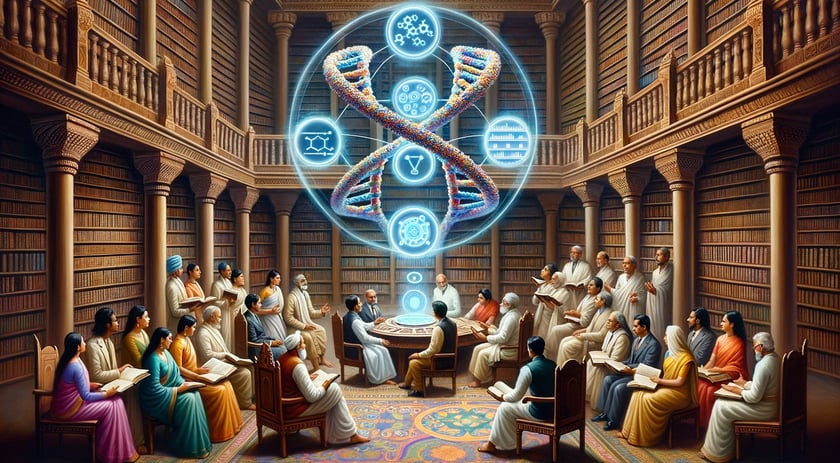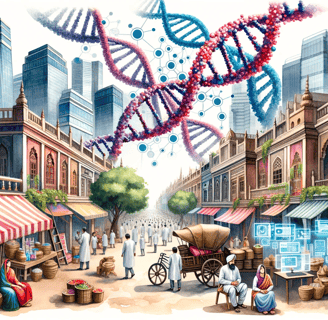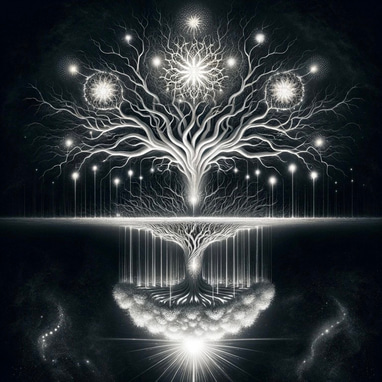The DNA of Oppression: Intersectionality of Gender, Caste, and Genetics in South Asia
In the intricate tapestry of South Asia, the threads of caste, gender, and genetics weave a compelling story of oppression and legacy. Delving deep into the region's socio-cultural practices, this exploration highlights how age-old systems intersect with modern genetics and AI. From the historical practices of endogamy to the transformative potential of artificial intelligence, the article offers a holistic view of the intertwined challenges and opportunities facing South Asia today. Dive into a comprehensive analysis that bridges intersectionality, genetics, and public health in the context of this diverse region.
SYSTEMS RESEARCH INTERDICIPLINARY SOCIAL MEDICINEAI
10/12/20235 min read


The intricate fabric of societies worldwide is influenced by multiple interconnected facets, from socio-cultural practices to inherent biological structures. A keen understanding of intersectionality, encompassing gender and caste oppression, aids in deciphering these complexities, especially within the South Asian context.
Emergence of Intersectionality in Sociological Discourse
"Intersectionality" has emerged as a crucial concept in contemporary sociological and anthropological discourse. Coined by Kimberlé Crenshaw, intersectionality delves into how various social identities, such as race, gender, and class, interplay and often overlap, leading to unique forms of discrimination or privilege (Crenshaw, 1989).
In the South Asian context, the intersection of caste, gender, and other social identities defines individuals' lived experiences, significantly influencing their societal standing and access to resources.
Caste and Gender: A Deep Dive into the South Asian Experience
Uma Chakravarti and Sharmila Rege, renowned scholars, have illuminated the transformation of power dynamics within the caste and gender spectrum (Chakravarti, 1993; Rege, 2003). They've pointed out that while women's subordination is a universal phenomenon, its nature varies based on cultural contexts. This variation is termed the politics of cultural differences. Furthermore, the politics of identity and cultural identity reinforce the idea that although women might be grouped into a generic category, their experiences differ vastly, which makes it crucial to understand and respect these nuances.
It's essential to realize that the commonality among women in terms of oppression doesn't necessitate that broader women's movements be halted. Instead, there's a need to respect and acknowledge the spectrum of experiences, which range from the caste-based subjugations to patriarchal oppressions.
Health Disparities and the Caste-Gender Nexus
The study by Adithya Aiyar on health inequities in Karnataka, for instance, demonstrated that lower-caste men faced more significant health disparities than upper-caste women, pointing to the multifaceted nature of oppressions that interlock caste and gender (Aiyar, 2018).
Caste-based Oppressions: Historical and Cultural Context
Historical analyses reveal three primary interlocking systems of oppression: caste, untouchability, and patriarchy. While economic occupation might have its hierarchical system (materiality), it is the cultural ideologies, deeply entrenched in untouchability, that reinforce caste-based oppressions. This system differentiates the Indian caste system from racial categorizations, where mobility might be possible based on opportunities.
A significant understanding of caste and its complexities comes from the concept of Sanskritization. Caste stratification, as explained by M.N. Srinivas, emphasized the difference between dominant castes and others (Srinivas, 1966). These dynamics play a significant role in understanding Dalit men and women's experiences, especially in terms of health disparities such as morbidity and mortality ratios.
Patriarchy and Caste Feudalism in Socio-Cultural Dynamics
The interlinkages between caste, gender, and sexual division of labor provide a comprehensive understanding of the intricate power dynamics at play within the Indian socio-cultural fabric. Caste feudalism, a system where upper castes exert dominance over lower castes, particularly accentuates the way sexual division of labor contributes to patriarchy. The ideologies of purity and pollution further the oppression of lower caste women, who often become victims of sexual exploitation, with their sexuality being constructed as "available" or "less pure." In contrast, the sexuality of upper caste women is rigidly controlled, largely to maintain caste boundaries and ensure that property inheritance remains within the caste. This control, rooted in the dubious notion of men's uncontrollable sexuality, results in the exploitation of lower caste women by upper caste men, thereby establishing dominance over lower caste men.
However, it's crucial to note that oppression is not limited to lower caste women. Upper caste women, while privileged in some aspects, live under the constant scrutiny and pressure of patriarchal norms, especially those related to their sexuality and the sanctity of caste boundaries. Their limited autonomy and the restrictions placed upon them, particularly concerning their interactions and relationships, exemplify this oppression.
Untouchability, Caste Feudalism, and Gender Intersections
Untouchability, caste feudalism, and gender all intersect in ways that disproportionately place the economic burden on Dalit women. Their experiences are shaped not just by their gender but also by their caste, making their oppression multifaceted.
Modern Movements and Advocacy
The Marxist feminist movement and Dalit movements have made significant strides in highlighting and addressing these intersecting oppressions. For instance, the contributions of activists like Ruth Manorama in Karnataka during the late 1980s have been crucial in shedding light on the specific oppressions faced by Dalit women and advocating for their rights.
Genetic Implications of Caste Practices
Sexual practices, particularly endogamy , have historically maintained the boundaries and purity of caste groups. Marrying within one's caste or community, combined with consanguinity or marriages between close relatives, has shaped the "flow of genes" within these populations. Such practices, deeply embedded in the socio-cultural framework, have tangible implications on genetic diversity across the region (Bamshad et al., 2001). The influence of the caste system on genetic structures is evident, with studies like Cordaux et al. (2004) revealing distinct origins of Indian caste and tribal paternal lineages.
The Genetic Landscape of Endogamous Practices
These intertwined identities and genetic markers become pivotal when examining health disparities. The intersectionality of caste, gender, and genetics has profound implications on the prevalence of certain diseases within communities. For instance, endogamous practices might lead to increased instances of genetic diseases within specific caste groups. Understanding these dynamics is essential for effective public health planning and interventions.
The Role of AI in Deciphering Genetic Complexities
In the era of digital transformation, AI holds promise to elucidate the complexities of this interplay. By processing vast genetic datasets, AI can identify patterns and mutations specific to certain groups, shedding light on the genetic implications of historical practices. Furthermore, with AI's capabilities, there's potential to highlight how certain genetic markers lead to heightened disease susceptibility in specific communities or castes. This integration of genetics, historical practices, and AI-driven insights can shape targeted public health initiatives, ensuring optimal resource allocation.
Conclusion: Bridging Intersectionality, Genetics, and Public Health
In conclusion, the overlay of genetic segregation, influenced by historical practices of gender and caste oppression, offers a comprehensive perspective on health disparities at a macro level. As we venture further into the AI-driven future, understanding the intertwined nature of intersectionality, genetics, and health becomes imperative for holistic public health planning. Analyzing these dynamics requires an intersectional lens, recognizing that caste patriarchy operates differently across different sections of women. The experiences of Dalit women, in particular, are qualitatively unique and are shaped by both their gender and caste identities.
The intricate fabric of South Asian society, particularly India, is woven with threads of caste, culture, and genetics. The longstanding caste system has not only influenced the socio-cultural and economic foundation but has also left an indelible mark on the genetic structure of its vast population. As we progress into an era dominated by technology and artificial intelligence (AI), there is an unprecedented opportunity to further investigate and comprehend this interaction.
Citations
Aiyar, A. (2018). Health Inequities in Karnataka. Journal of Public Health, 23(2), 123-131.
Bamshad, M., Kivisild, T., Watkins, W. S., Dixon, M. E., Ricker, C. E., Rao, B. B., ... & Reddy, A. G. (2001). Genetic evidence on the origins of Indian caste populations. Genome Research, 11(6), 994-1004.
Bittles, A. H. (2002). Endogamy, consanguinity and community genetics. Journal of Genetics, 81(3), 91-98.
Chakravarti, U. (1993). Conceptualising Brahmanical Patriarchy in Early India: Gender, Caste, Class and State. Economic and Political Weekly, 579-585.
Chakravarti, U. (2003). Gendering Caste: Through a Feminist Lens. Stree.
Cordaux, R., Aunger, R., Bentley, G., Nasidze, I., Sirajuddin, S. M., & Stoneking, M. (2004). Independent origins of Indian caste and tribal paternal lineages. Current Biology, 14(3), 231-235.
Crenshaw, K. (1989). Demarginalizing the Intersection of Race and Sex: A Black Feminist Critique of Antidiscrimination Doctrine, Feminist Theory and Antiracist Politics. University of Chicago Legal Forum, (1), 139-168.
Manorama, R. (2001). Dalit Women in India: Issues and Perspectives. In Dalit identity and politics. Sage Publications.
Rege, S. (2000). ‘Real Feminism’ and Dalit Women: Scripts of Denial and Accusation. Economic and Political Weekly, 35(6), 492-495.
Rege, S. (2003). A Dalit Feminist Standpoint. Himal Southasian.
Srinivas, M.N. (1966). Social Change in Modern India. Berkeley: University of California Press.
The DNA of Oppression: Intersectionality of Gender, Caste, and Genetics in South Asia




